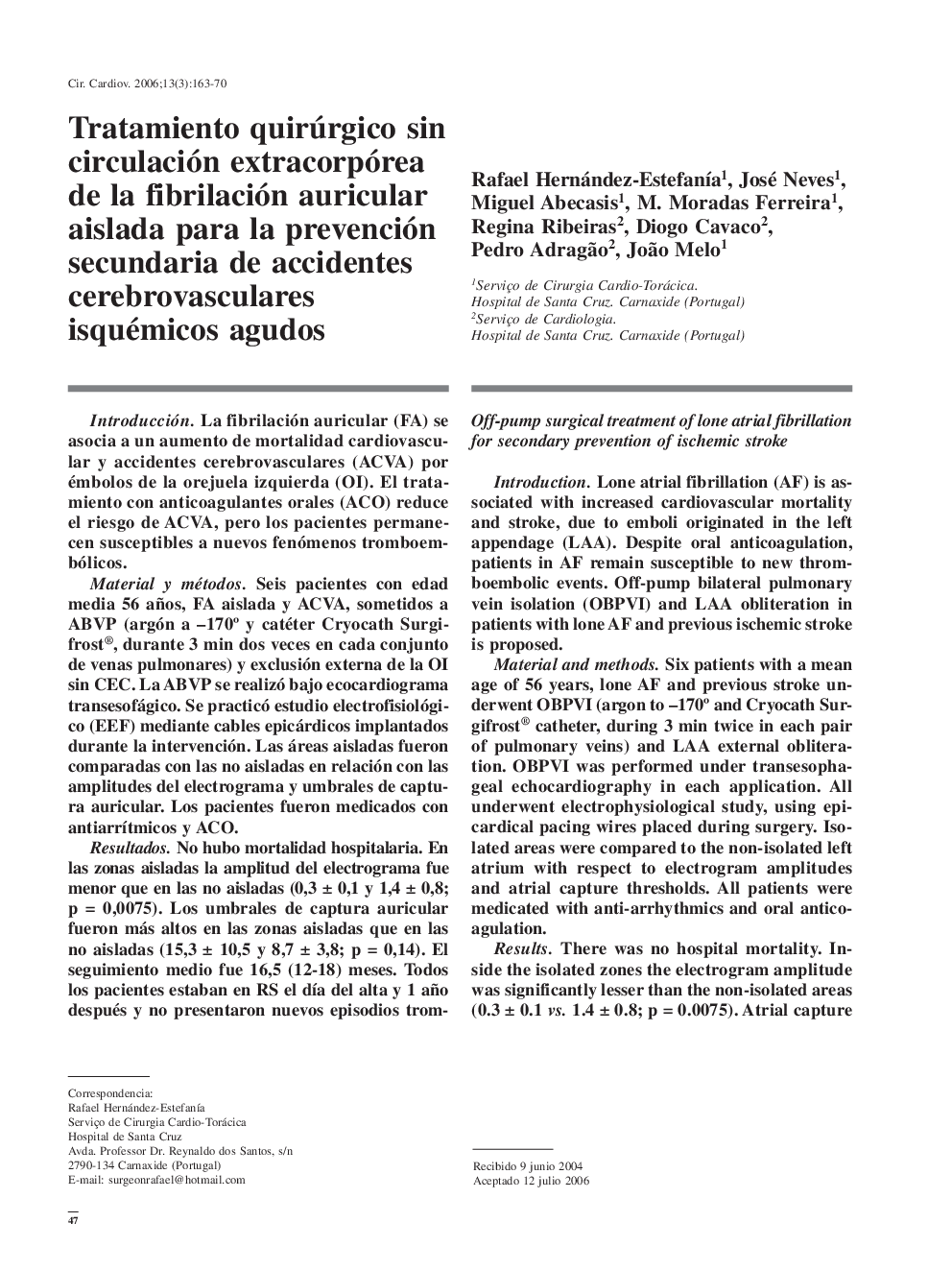| Article ID | Journal | Published Year | Pages | File Type |
|---|---|---|---|---|
| 2908209 | Cirugía Cardiovascular | 2006 | 8 Pages |
IntroducciónLa fibrilación auricular (FA) se asocia a un aumento de mortalidad cardiovascular y accidentes cerebrovasculares (ACVA) por émbolos de la orejuela izquierda (OI). El tratamiento con anticoagulantes orales (ACO) reduce el riesgo de ACVA, pero los pacientes permanecen susceptibles a nuevos fenómenos tromboembólicos.Material y métodosSeis pacientes con edad media 56 años, FA aislada y ACVA, sometidos a ABVP (argón a –170° y catéter Cryocath Surgifrost®, durante 3 min dos veces en cada conjunto de venas pulmonares) y exclusión externa de la OI sin CEC. La ABVP se realizó bajo ecocardiograma transesofágico. Se practicó estudio electrofisiológico (EEF) mediante cables epicárdicos implantados durante la intervención. Las áreas aisladas fueron comparadas con las no aisladas en relación con las amplitudes del electrograma y umbrales de captura auricular. Los pacientes fueron medicados con antiarrítmicos y ACO.ResultadosNo hubo mortalidad hospitalaria. En las zonas aisladas la amplitud del electrograma fue menor que en las no aisladas (0,3 ± 0,1 y 1,4 ± 0,8; p = 0,0075). Los umbrales de captura auricular fueron más altos en las zonas aisladas que en las no aisladas (15,3 ± 10,5 y 8,7 ± 3,8; p = 0,14). El seguimiento medio fue 16,5 (12-18) meses. Todos los pacientes estaban en RS el día del alta y 1 año después y no presentaron nuevos episodios tromboembólicos. Un paciente presentó episodios de FA paroxística autolimitada en los primeros 3 meses sin repercusión.ConclusionesNuestra experiencia inicial en el tratamiento de la FA aislada mediante ABVP con argón y sin CEC ofrece buenos resultados. Debe documentarse la persistencia del efecto y su eficacia en la reducción de los fenómenos tromboembólicos.
IntroductionLone atrial fibrillation (AF) is associated with increased cardiovascular mortality and stroke, due to emboli originated in the left appendage (LAA). Despite oral anticoagulation, patients in AF remain susceptible to new thromboembolic events. Off-pump bilateral pulmonary vein isolation (OBPVI) and LAA obliteration in patients with lone AF and previous ischemic stroke is proposed.Material and methodsSix patients with a mean age of 56 years, lone AF and previous stroke underwent OBPVI (argon to –170° and Cryocath Surgifrost® catheter, during 3 min twice in each pair of pulmonary veins) and LAA external obliteration. OBPVI was performed under transesophageal echocardiography in each application. All underwent electrophysiological study, using epicardical pacing wires placed during surgery. Isolated areas were compared to the non-isolated left atrium with respect to electrogram amplitudes and atrial capture thresholds. All patients were medicated with anti-arrhythmics and oral anticoagulation.ResultsThere was no hospital mortality. Inside the isolated zones the electrogram amplitude was significantly lesser than the non-isolated areas (0.3 ± 0.1 vs. 1.4 ± 0.8; p = 0.0075). Atrial capture thresholds were higher for the isolated areas (15.3 ± 10.5 vs. 8.7 ± 3.8; p = 0.14). Mean follow-up was 16.5 (12-18) months. All patients were in SR at discharge and one year after surgery, none presented new stroke events. One had self-limited paroxysmal AF during the first 3 months without clinical manifestation.ConclusionsOur initial experience in the treatment of lone AF with OBPVI with argon had good results. Long-term follow-up is needed to assess the efficacy in reducing thromboembolic events.
